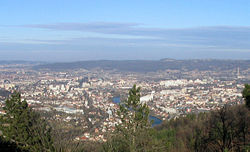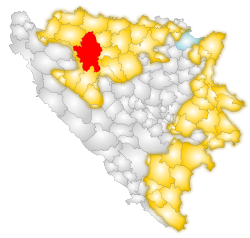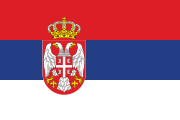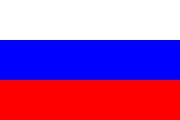Banja Luka
| Banja Luka Бања Лука |
|
 |
|
 |
|
| Coordinates: | |
| Country | |
|---|---|
| Entity | Republika Srpska |
| Government | |
| - Mayor | Dragoljub Davidović (SNSD) |
| Area | |
| - City | 1,232 km² (475.7 sq mi) |
| Population | |
| - City | 227,000 |
| - Density | 178.6/km² (462.6/sq mi) |
| - Metro | 270,000 |
| Time zone | CET (UTC+1) |
| - Summer (DST) | CEST (UTC+2) |
| Area code(s) | +387 51 |
| Website: http://www.banjaluka.rs.ba | |

Banja Luka or Banjaluka (Cyrillic: Бања Лука, pronounced [ˌbaɲaˈluːka]) is the de facto capital and the largest city in the Republika Srpska entity and the second largest city of Bosnia and Herzegovina after Sarajevo. It has traditionally been the center of the Bosanska Krajina region located in the northwest of the country, on the Vrbas river. It is home to the University of Banja Luka, as well as other numerous institutions of Republika Srpska and Bosnia and Herzegovina. The city is well-known in the former Yugoslavia for being full of tree-lined avenues, boulevards, gardens, and parks.[1]
Contents |
Geography
Banja Luka covers some 96.2 km² (37.1 mi²) of land in northwestern Bosnia on the Vrbas River. The city is located at . Banja Luka's downtown is at 163 m above sea level, surrounded by hills.
The source of the Vrbas River is about 90 km (56 mi) to the south. The tributary rivers of Suturlija, Crkvena, and Vrbanja flow into the Vrbas at Banja Luka. Banja Luka also has a number of springs close by.
The area immediately around Banja Luka is woodland, although there are mountains a little further from the city. The city itself is built in the Banja Luka valley, which is located at the transition between high and low mountain areas. The most notable of these mountains are Manjača (1214 meters), Čemernica (1,338 meters), and Tisovac (,meters). These are all part of the Dinaric Alps mountain range.
Climate
Banja Luka has a continental climate, with harsh winters and warm summers. The warmest month of the year is July, with an average temperature of 21.3 °C (70 °F). The coldest month of the year is January, when temperatures average near freezing at 0.8 °C (33 °F).
Annual precipitation for Banja Luka is about 988 mm. Banja Luka has an average of 143 rainy days a year. Due to the city's high latitude, it snows in Banja Luka almost every year as well. Strong winds come from the north and northeast.
History
The name "Banja Luka" was first mentioned in a document dated February 06, 1494, but Banja Luka's history dates back to ancient times. There is substantial evidence of a Roman presence in the region during the first few centuries AD, including an old fort "Kastel" in the center of the city. The area of Banja Luka was wholly in the Roman province of Illyricum, lying on important Roman roads between Dalmatia and Pannonia.
Slavs settled the area in the 7th century A.D., although the exact nature of their migrations remains something of a mystery. What is known is that the first mention of the city dates to 1494, by Vladislav II. The name means "Ban's meadow", from the words ban ("a medieval dignitary"), and luka ("a valley" or "a meadow"). The identity of the ban and the meadow in question remain uncertain, and popular etymology combines the modern words banja ("bath" or "spa"), or bajna ("marvellous") and luka ("port"). In modern usage, the name is pronounced and usually declined (u Banjaluci) as one word, and often written as such; the citizens reportedly prefer the more correct form with inflected adjective (u Banjoj Luci).[2]
One of the first public structures after Kastel was a Franciscan monastery, built in 1378 in Banja Luka’s neighborhood of Petrićevac by Bosnian Franciscans. It was the first of such buildings in Bosnia.

During the Ottoman rule in Bosnia, Banja Luka was the seat of the Bosnian pashaluk, and the lords of the region built what is nowadays the main street of the city. Between 1566 and 1574 Ferhat-paša Sokolović, one of the founders of the Banjaluka’s town core, built over 200 projects ranging from artisan and sales shops to wheat warehouses, baths and mosques. Among his more important constructions were Ferhadija and Arnaudija mosques, during which construction a plumbing infrastructure was laid that served surrounding residential areas. All this stimulated economic and urban development of Banja Luka, that soon after became one of the leading commercial and political centers in Bosnia. In 1688 the city was set to the torch by an Austrian army, but it quickly recovered. Later periodic intrusions by the Austrian army stimulated military developments in Banja Luka, which made it into a strategic military center. Serb churches and monasteries near Banja Luka were built in the 19th century. In the 19th century Sephardic Jews and Trappists migrated to the city, which contributed to the early industrialization of the region by building mills, breweries, brick factories, textile factories and other important structures. For all its leadership to the region however, Banja Luka as a city was not modernised until rule by Austria-Hungary in the late 19th century.
Austrian occupation brought westernization to Banja Luka. Railroads, schools, factories, and infrastructure appeared, and were developed. This led to a modern city, that after World War I became the capital of the Vrbas Banovina, a province of the Kingdom of Yugoslavia.
It owed its rapid progress to the first Ban Svetislav Milosavljević. During that time Banski dvor and its twin sister the Administration building, the Serbian Orthodox Church of the Holy Trinity, theatre and museum were built, Grammar school was renovated, Teachers College enlarged, city bridge was also built and the park renovated. 125 elementary schools worked in Banja Luka in 1930. Revolutionary ideas of the time along the city were allocated by the association "Pelagić" and Student's Club. Banjaluka naturally became the organizational centre of anti-fascist work in the region.

During World War II, Banja Luka was occupied by the mostly Nazi regime. Most of Banja Luka's noble Serbs and Sephardic Jewish families were deported to nearby concentration camps such as Jasenovac and Stara Gradiška. On February 7, 1942 the Ustaše forces, led by a Franciscan monk, Miroslav Filipović (aka Tomislav Filipović-Majstorović) killed 2,500 Serbs (among them 500 children) in Drakulići, Motike and Sargovac (part of the Banja Luka municipality). The town's Orthodox church of the Holy Trinity was razed to the ground by the Nazi German occupation authorities [1]. The city was finally liberated on April 22, 1945. Banja Luka gave its many WWII heroes, like sister and brother Vahida and Osman Maglajlic. The nursing school in Banja Luka had her name.

In 1969, a devastating earthquake damaged many buildings in Banja Luka. A large building called Titanik in the center of the town was razed to the ground, and the area was turned into a central public square. With contributions from all Socialist Federal Republic of Yugoslavia regions, Banja Luka was repaired and rebuilt. That was the period when a large Serb population moved to the city from the surrounding areas, and distant areas in Herzegovina. However, much of the old city center that had many small buildings and shops from Austrian-Hungarian and Ottoman periods were damaged beyond repair and were subsequently razed.
The city underwent considerable changes during the Yugoslav wars. Upon the declaration of Bosnian-Herzegovinian independence and establishment of Republika Srpska, Banja Luka became the de facto center of the entity's politics. Many Serb refugees who were forced to leave formerly Republika Srpska Krajina, Croatia and the Federation of Bosnia and Herzegovina (mostly from Sanski Most and Kljuc) moved to the city and its surroundings in the mid-1990s.
Demographics
Today, it has been estimated that the population of the municipality of Banja Luka is about 198,000 (slightly above 227,000 if those registered in Banja Luka but residing abroad are counted).[3] Although there is a lack of more recent official statistics on ethnic distribution, there is little doubt that Serbs make up an overwhelming majority in the city.
- Serbs (90%)
- Bosniaks (7%)
- Croats (2%)
- Others (1%)
Government

Banja Luka plays an important role on different levels of Bosnia and Herzegovina's government structures. Banja Luka is the center of government for the Municipality of Banja Luka.
A number of entity and state institutions are seated in the city. The Republika Srpska Government and the National Assembly are based in Banja Luka. The Bosnia and Herzegovina State Agencies based in the city include the Indirect Taxation (VAT) Authority, the Deposit Insurance Agency as well as a branch of the Central Bank of Bosnia and Herzegovina (formerly the National Bank of Republika Srpska).
Austria, Croatia, France, Germany, Serbia, United Kingdom and the United States maintain diplomatic representation through consulate-generals in Banja Luka.
Economy

Although the city itself was not directly affected by the war in the early 1990s, Banja Luka's economy was. For four years, Banja Luka fell behind the world in key areas such as technology, resulting in a rather stagnant economy today.
In recent years, financial services sector has gained in importance in the city. In 2002, trading began on the newly-established Banja Luka Stock Exchange. Since then, the stock exchange has gone from strength to strength. The number of companies listed, the trading volume and the number of investors have increased significantly. A number of big companies such as Telekom Srpske, Rafinerija ulja Modriča, Banjalučka Pivara and Vitaminka are all listed on the exchange and are traded regularly. Investors, apart from those from Slovenia, Croatia and Serbia, now include a number of investment funds from the EU, Norway, USA, Japan and China.
A number of financial services regulators, such as the Republika Srpska Securities Commission and the RS Banking Agency are headquartered in Banja Luka. This, along with the fact that some of the major banks in Bosnia, the Deposit Insurance Agency and the Value-added tax (VAT) Authority are all based in the city, has helped Banja Luka establish itself as the main financial centre of the country.
Culture

Due to its long history, Banja Luka has a rich culture. A number of museums can be found in the city, including the Museum of Republika Srpska also known as the Museum of Bosanska Krajina, and the Ethnographic Museum, established in 1930. Banja Luka also has a national theatre, and library, both dating from the first half of the 20th century. There are numerous other museums and theatres in the city including the Museum of Modern Art of Republika Srpska.

One of the most famous cultural sites in Banja Luka is the cultural centre "Banski Dvor" (Halls of the Ban), built in the 1930s as a spot of residence for the Bans of the Vrbas Banovina. It is a beautiful building in the very center of the city. The National Assembly is inside, along with a concert hall, gallery, state television, and restaurant. Most of the main cultural and political leadership nowadays takes place inside of the building.
The relatively poorly preserved fortress Kastel is found in the center of the city. This medieval castle is one of Banja Luka’s main attractions but has recently become a dangerous place at night. Located on the bank of the Vrbas River, it gave specific charm to the city. During the summer some concerts took place in the fortress.
In the city there are many Cultural Artistic Associations. The oldest is RKUD "Pelagić" (1927), and it is one of the oldest institution of this kind in Bosnia and Herzegovina [2].
Events
In the summer, there are many festivals going on, with live bands playing outdoor venues, DJ’s and dances put on. The main festivals include: Banja Luka Choir Gathering (April - May), Theater Festival "Teatar Fest" (May), International Short Film Festival "Kratkofil" (June), The Month of Rock Music (June), Folklore Days Banja Luka (July - August, every Thursday), Summer on the Vrbas (July) Banja Luka Summer Games (August) as well as the Banja Luka Fashion Week.
Sport
Banja Luka has one major football stadium and several indoor sports halls. The local handball and football teams bear the traditional name Borac (fighter), though the basketball club was recently renamed to Banjalučka pivara, after the Banja Luka brewery. The three football teams from Banja Luka are Borac Banja Luka (Premier League of Bosnia and Herzegovina), FK BSK Banja Luka, and FK Omladinac Banja Luka (both in the First League of the Republika Srpska), and FK Naprijed Banjaluka.
The city has a long tradition of good handball players and teams. RK Borac Banjaluka was the European Champion in 1976, the European Vice-Champion in 1975 and the winner of the IHF Cup in 1991.
Recently, tennis has taken on a bigger role in the city. The local tennis tournament, "Memorijal Trive Vujića", has become professional and has been awarded ATP status in 2001, with the rank of a Challenger. The Banja Luka Challenger takes place in September each year. Also, in 2006, the Davis Cup matches of the Europe/Africa Zone Group III took place in the city. Apart from Bosnia and Herzegovina, the teams included Monaco, Estonia, Turkey, Lithuania, Moldova, Armenia and Andorra.
In 2005, the European Championships in Rafting were held on the river Vrbas. According to the International Rafting Federation: "The event was hugely successful and the hosts are to be praised for the exemplary manner in which they ran the event, managed the media and looked after the competitors, staff and spectators...". Many nations took part, with the Czech Republic being the most successful.
Tourism
The natural beauties of the surrounding area guarantee the city of Banja Luka a good position in tourism. Banja Luka has a number of hotels, the oldest one dating back to 1885. One of hotels is Hotel Marriott, which is right on the river Vrbas. The city and surrounding area have a number of popular tourist attractions. Among the most famous are the pools, thermal springs, and spas in the region. Banja Luka was once nicknamed the "Green City", due to its parks, and over 10,000 trees. The area is popular among nature lovers, while the city center is attractive to tourists due to its historical structures and many restaurants. Another attractive sights of Banja Luka are the Banj Hill and a waterfall of the river Vrbas near Krupa. Rafting on the Vrbas is currently getting more appreciated among local tourists. There are also opportunities for fishing, rock climbing and hiking along the canyon of the Vrbas between Banja Luka and Jajce.
Transportation

Public transportation within Banja Luka is exclusively operated by bus services. Over 30 bus lines connect downtown with the rest of the city and suburbs. The oldest bus link in the city is No 1.
Taxis are readily available in the downtown and by phone.
Banja Luka International Airport (IATA: BNX, ICAO: LQBK) is located 23 km from Banja Luka. Three airlines fly to the airport at present, B&H Airlines, Jat Airways and Austrojet with regular flights to Zurich, Salzburg, Belgrade and Sarajevo. Charter flights also operate from the airport, and the airport can be used as a back-up to Sarajevo Airport. Zagreb Airport, often preferable in the winter to Sarajevo due to weather conditions, is approximately two hours away via an excellent highway.
Banja Luka is the hub of the railway services of the Željeznice Republike Srpske (tr. Railways of Srpska), one half of the railway network of Bosnia and Hercegovina. Services operate to most northern Bosnian towns, Zagreb (twice daily), and Belgrade, (and from there on to the rest of Europe), though due to the recent conflict and the restoration of much of the rail network and a lack of carriages, services remain slow and infrequent compared with neighbouring countries.
A wide range of bus services are available to most neighbouring towns and every large city in Bosnia and Herzegovina, and international bus services are available to and from Austria, Croatia, Germany, France, Italy, Montenegro, The Netherlands, Serbia, Sweden, Switzerland and Slovakia.
The modern highway M-16 leads north to Zagreb and other destinations in Croatia.
Sister Cities and international cooperation
 Bari, Italy
Bari, Italy Belgrade, Serbia, since 2003
Belgrade, Serbia, since 2003 Bitonto, Italy
Bitonto, Italy Kaiserslautern, Germany, since 2003
Kaiserslautern, Germany, since 2003 Kranj, Slovenia, since 2006
Kranj, Slovenia, since 2006 Lviv, Ukraine
Lviv, Ukraine Moscow, Russia, since 2003
Moscow, Russia, since 2003 Novi Sad, Serbia, since 2006
Novi Sad, Serbia, since 2006 Patras, Greece
Patras, Greece
People
- Abas Arslanagić, handball player/coach
- Adem Cejvan, actor
- Mustafa Nadarević, actor
- Ismet Bekrić, poet
- Nasiha Kapidžić-Hadžić, poet
- Mersad Berber, painter
- Anton Josipović, boxer
- Abid Kovačević, soccer player
- Zrinko Tutić, composer
- Petar Kočić, novelist
- Milorad Karalić, handball player
- Dr. Nebojša Popović, handball player
- Slađana Golić, basketball player
- Ivan Ljubičić, tennis player
- Jasenko "Jasa Tha Boss" Knežević, rapper and businessman
- Zdravko Rađenović, handball player
- Saša Lošić, singer, composer
- Dragan Šajnović, violinist, professor
- Marijan Beneš, boxer and poet
- Aleksandar Ravlić, journalist, photographer and writer
- Vlado Milošević, composer
- Zlatan Muslimović, football player
- Radovan Bisić, boxer
- Aleksandar Knežević, handball player
- Mladen Bojinović, handball player
- Marija Šestić, singer
- Maja Tatić, singer
- Goran Žižak, singer a.k.a. DJ Krmak
- Ivana Gagula Semi-finalist in Miss Earth 2007
- Nebojša Malešević, Mr Bosnia & Herzegovina (Mr World 2007 representative)
- Boris Rezak, singer
Gallery
References
- ↑ Oficijelna internet prezentacija grada Banjaluke
- ↑ Ivan Lovrenović, " ‘Serb’ towns in Bosnia", BH Dani, 20 July 2001
- ↑ Prostorni plan Republike Srpske do 2015. Banja Luka, April 2008. p. 67 & 69
External links
- Official page
- Official Banja Luka Tourism Page
- Banjaluka Portal
- Banjaluka BLog
- Guide through Banjaluka
- Banja Luka International Airport
- Banja Luka Stock Exchange
- Interactive city map of Banja Luka
- Events in Banja Luka and lots more
- Forum of Banjaluka's Diaspora
- Banja Luka is at coordinates
|
|||||||||||||||||||||||||||||